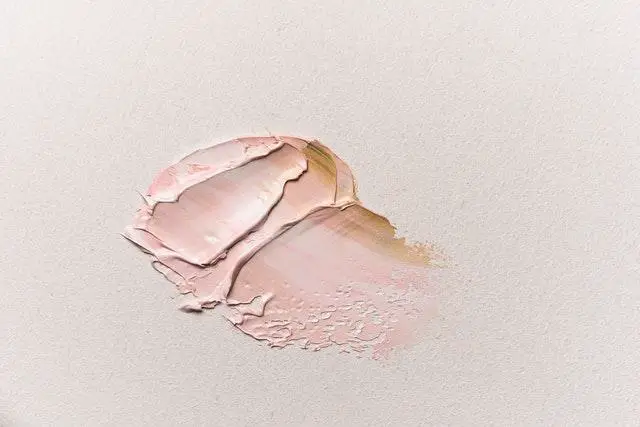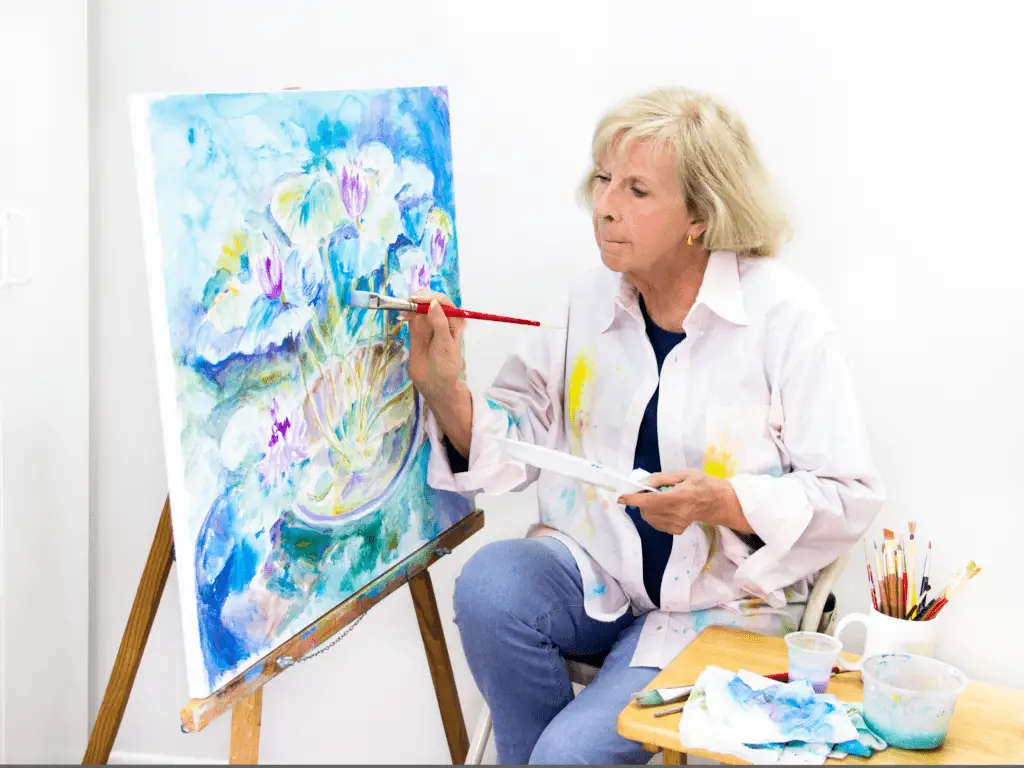In some cases, you might experience very slow-drying acrylic paint or you may wonder why is my acrylic paint not drying. I asked acrylic paint manufacturers what might be the reason and here is what I have found.
Acrylic paint will not dry or takes too long to dry when the temperature is low, humidity is high, painting on nonporous surfaces, low airflow, and paint in thick layers. Controlling these factors using different tools and techniques will speed up the drying process.
In this article, you will find out why your acrylic painting is not drying or is very slow to dry and how to speed up the drying process in detail.
5 Reasons why your acrylic paint not drying
There are 5 main things that affect the drying process of acrylic paint. By controlling these factors you can change the drying time. Following is a great video from Golden Paints that explains the factors affecting drying time.
Waterborne acrylics dry by evaporation of water from the film so any factor that controls evaporation will speed up or slow drying. More humid environments will allow slower drying. A dryer and warmer air will speed up drying.
Scott Bennett, Materials Specialist for GoldenPaints.com
Below I have explained the factors that might have caused your painting not to dry or dry very slowly in detail.
1. Painting in cold temperatures
Painting in cold temperatures slows the drying process rather than painting in a hot environment. The ideal temperature for drying or curing acrylic paints is 70 to 90oF( 21oC to 32oC). So if you are painting in a colder environment than 70oF( 21oC) acrylic paint will be drying slowly.
The temperature you are painting should never be lower than 50oF (10oC). Because it is the minimum film-forming temperature of acrylic paint. Below this temperature, you might see powdering, cracking, and poor adhesion of paint film to the surface.
2. Painting on nonporous surfaces
Absorbing into the painting surface is another method of acrylic paint drying. So if you are painting on a nonporous surface drying through surface absorption does not happen. Therefore drying process will be slower.
This happens in surfaces like glass, metal plastic, and glazed ceramics as they are nonporous. The slow drying will be most noticeable if the temperature is also low and the humidity is high.
3. Paining in high humidity
High humidity can slow the drying process. The ideal humidity to paint would be 75% or lower relative humidity. High humidity means more moisture in the air. When there is more moisture it reduces the evaporation of water from the paint film which contributes to the drying process.
Hence the higher the humidity, the slower the drying process would be. Make sure that you do not use a humidifier in the room. It increases the humidity and slows the drying process. Also spraying the painting with a spray bottle can slow the drying process because it increases moisture in the air.
4. Low airflow in the studio
If you are painting in a concealed environment, that has very low airflow, the drying will be slower. A steady moderate airflow helps to dry acrylic paint faster.
Airflow helps to carry away the evaporated water vapor near the painting quickly. This helps to evaporate more water from the paint film and dry quickly. When the airflow is low the water vapor stagnates near the painting making it difficult for more water to evaporate, making the drying process slow.
5. Painting in thick layers

In some cases, you will need to paint in thicker layers such as when doing some abstract art and especially when doing acrylic paint pours. Acrylic paint pours that are applied in thick layers may take around 3 days to 1 week to fully dry. Therefore thick paint layers are relatively slower to dry.
I have written a whole article about acrylic gesso drying time. You will know how to prime your painting support with gesso perfectly considering all other influencing factors.
Why is my acrylic paint still tacky?
Acrylic paint is sticky or tacky when it is not fully cured. Other factors such as poor ventilation, high humidity, use of low-quality paints, and thick painting layers also influence paint being sticky. Allowing the paint to fully cure and varnishing the painting reduces the stickiness.
I have written a whole article about acrylic paint being sticky and the best ways to avoid that. You can read that article to find answers and solve the paint being a tacky problem.
How long does acrylic paint take to dry fully?
Acrylic paint takes around 20 to 30 minutes to dry and 1 to 3 days to fully cure. Thick paint layers take several weeks to cure especially on nonporous surfaces. However, you can extend this drying time if you want more time to blend colors. other than controlling the above-mentioned factors you can use a few additives from manufacturers.
Use additives such as our Retarder or our OPEN Thinner added to your paints in amounts not to exceed about 20% to slow drying. We also have a slow-drying paint line called OPEN Acrylic.
Scott Bennett, Materials Specialist for GoldenPaints.com
I have written a whole article on ‘How long acrylic paint to cure? (Comprehensive answer)‘. You will learn more about curing, even the process acrylic paint goes through to dry and cure.
How to make acrylic paint dry faster
You can make acrylic paint dry faster by changing the above-mentioned factors; temperature, surface, humidity, airflow, and thickness of the paint film. Below I have explained how you can control these influential factors to speed up the drying of acrylic paint.
1. Paint in temperatures above 70oF (21oC)
Acrylic paint dries faster in heat rather than in cold environments. Paint in an environment higher than the minimum ideal drying temperature of acrylic paint which is 70oF. A hairdryer or heat lamp can be used to increase temperature and speed up the drying process.
Drying acrylic paint with a hairdryer or heat lamp…
A hairdryer or a heat lamp is a great tool to dry acrylic paints. It significantly reduces the drying time. However, if you heated the paint film too much, it can burn or create air pockets like bubbles. This is why you should never use a heat gun that reaches extremely high temperatures like more than 100oC.
However, you will not essentially need a hair drier to make acrylic paint dry faster. Below I have explained the other ways you can make the paint dry faster without a hairdryer.
I have written a whole article about ‘How can you tell if acrylic paint is bad? (common signs)‘. You can find many ways acrylic paint can go bad including drying out and how to avoid or fix each case there.
2. Paint in an environment with 75% or less humidity
As said before high humidity causes slow drying. Therefore lowering humidity to 75% helps with the drying process. You can also use a dehumidifier for this purpose. Also, avoid spraying your painting with a spray bottle as it increases the drying time by increasing the humidity.
3. Allow steady medium airflow into the studio
Airflow helps with the drying process. So you can ensure that your painting environment has good airflow. You can open windows and doors to facilitate airflow. Also, you can use a fan. However, do not direct the heavy airflow from the fan directly onto the painting. It can cause cracking and wrinkling of the paint film, especially when doing acrylic pours.
4. Paint in thin layers
It is obvious that thick paint layers dry slowly and thin paint layers dry quicker. If you want to speed up the drying process paint in thin layers. It will dry a lot quicker. This is because thin paint layers have less water and are easier to evaporate.
5. Paint on porous surfaces

Porous surfaces like canvas and wood help to absorb paint into the surface and speed up the drying process. Therefore use primed canvas and primed wood with gesso for acrylic paintings.
However, hardwoods like hardboard are less porous. It will result in slower drying times. To speed up the drying process you can avoid surfaces like glass, metal, glazed ceramic, plastics, and hardwoods (less porous).
I have written a whole article about the 17 pros and cons of acrylic paint. You can find all the important aspects of acrylic paint there.
Conclusion
Acrylic paint dries slowly when the temperature is low, humidity is high, painting thickly on nonporous surfaces, and painting in an environment with low airflow. You can increase or decrease drying time by controlling these factors. Also, if you are interested in keeping acrylic paints wet and workable for a long time, OPEN acrylic from Golden is the best choice.


